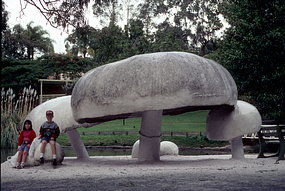
But a six meter high fungus? We need to go back a few millennium. Scientists in the UK discovered fossilized trees from one of the first forests on earth, dating back nearly 400 million years. These trees emerged from a world of early plants barely a few centimeters tall.
But not everything was small. In this ancient forest near Rhynie in Aberdeenshire, there were what the New Scientist writer James O'Donoghue described last year as 'featureless columns standing up to 8 meters high and a meter wide at the bases'.
When similar structures were first discovered, in Quebec, they were thought to be the trunk of a conifer tree. It turns out they are not made of wood at all. They are giant fungi. By measuring carbon isotopes, scientists can find out how an organism gets its food. In this case (reported in the journal Geology, volume 35, pages 399-402), it was clearly from rotting material.
Some of these giant fungi, called Prototaxites (a name given to them when they were thought to be a conifer - 'Taxus' is the botanical name for the Yew) were living off bacteria, algae and lichenised fungi.
So ferns, conifers, flowering plants and the like (the vascular plants) hadn't really conquered the land when these giant fungi ruled the land.
Today fungi aren't so big above the ground, but in fact they may well be still the biggest living things on earth. Work a few years ago by John Cairney and Nicole Sawyer at the University of Western Sydney demonstrated that when we see any toadstools they may belong to a single organism up to 30 m in diameter or the size of a tennis court.
And there are reports of that annoying Armillaria fungus penetrated through 15 hectares of soil and weighing something like 10 tonnes. Maybe not the species that causes Armillaria root rot in our gardens but you see why fungi can be so difficult to control.



Reader Comments
to our Newsletter